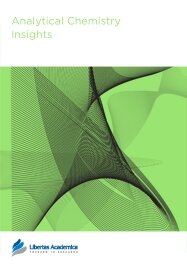

Publication Date: 15 Oct 2008
Journal: Analytical Chemistry Insights
Citation: Analytical Chemistry Insights 2008:3 135-143

The aim of this study is to adopt the approach of metabolic fingerprinting through the use of Fourier Transform Infrared (FTIR) technique to understand changes in the chemical structure in Padina tetrastromatica (Hauck). The marine brown alga under study was grown in two different environmental conditions; in natural seawater (P. tetrastromatica (c)) and in seawater suplemented with 50 ppm of cadmium (P. tetrastromatica (t)) for a three-week period in the laboratory. The second derivative, IR specrum in the mid-infrared region (4000–400 cm−1) was used for discriminating and identifying various functional groups present in P. tetrastromatica (c). On exposure to Cd, P. tetrastromatica (t) accumulated 412 ppm of Cd and showed perturbation in the band structure in the mid-IR absorption region. Variation in spectral features of the IR bands of P. tetrastromatica (untreated and treated) suggests that cadmium ions bind to hydroxyl, amino, carbonyl and phosphoryl functionalities. This was attributable to the presence of the following specific bands. A band at 3666 cm−1 in untreated P. tetrastromatica (c) while a band at 3560 cm−1 in Cd-treated P. tetrastromatica (t) due to non bonded and bonded O-H respectively. Similarly, non bonded N-H for P. tetrastromatica (c) showed two bands at 3500 cm−1 and 3450 cm−1 due to the N-H stretching vibrations and a band at 1577cm−1 due to N-H bending vibrations, while an intense band at 3350 cm−1 due to bonded N-H stretching vibrations and at 1571 cm−1 due to bending vibrations was observed for Cd-treated P. tetrastromatica (t). Involvement of ester carbonyl group is characterized by the presence of a band at 1764 cm−1 in untreated P. tetrastromatica (c) while the Cd-treated P. tetrastromatica (t) showed the band at 1760 cm−1. The intensity of the band at 1710 cm−1 in the control samples decreased drastically after cadmium treatment indicating carbonyl of COOH to be involved in metal chelation. A band at 1224 cm−1 for untreated P. tetrastromatica (c) and at 1220 cm−1 for Cd-treated P. tetrastromatica (t) is indicative of the involvement of phosphoryl group in metal binding. Several other such changes were also evident and discussed in this paper. Based on our observation, FTIR technique proves to be an efficient tool for detecting structural changes and probable binding sites induced by the presence of a metal pollutant, cadmium, in the marine environment.
PDF (333.86 KB PDF FORMAT)
RIS citation (ENDNOTE, REFERENCE MANAGER, PROCITE, REFWORKS)
BibTex citation (BIBDESK, LATEX)
XML
PMC HTML


I have published more than thirty research papers in internationally reputed high impact factor journals including Libertas Academica publications, Proteomics Insights and Analytical Chemistry Insights. I have no hesitation in saying that Proteomics Insights is highly efficient for its rapid and high quality review process and keeping the authors informed at each stage of the publication process. I recommend this journal for students, teachers and research workers who wish to publish their work. ...
Facebook Google+ Twitter
Pinterest Tumblr YouTube